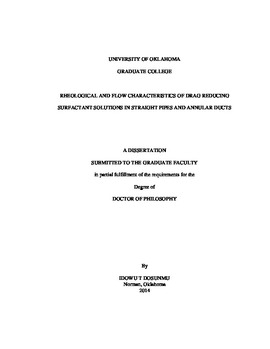| dc.description.abstract | Surfactants are well-known as effective drag reducers and viscosifying agents. The macroscopic properties of surfactants are dictated by the surfactant type and the condition of the solvent in which the surfactant is dissolved. In an aqueous medium, surfactants tend to aggregate, forming micelles that can vary in size and shape depending on several factors.
Scare information is available on the rheological and drag reduction characteristics of surfactant fluids particularly for oilfield operations. The objective of this research is to elucidate the rheological and drag reducing behavior of non-Newtonian surfactant fluid systems (Aromox® APA-T and APA-TW). In this work, the flow behavior of surfactants is studied in the context of pseudoplastic fluids. The rheological properties are measured using the Couette-type viscometer and rheometer. Flow behavior and drag reduction are investigated in straight pipes and annular ducts of different diameters in recirculation mode.
The rheological properties of test solutions (in fresh water, 2% KCl and 2% CaCl2) at various concentrations are studied using steady shear and dynamic testing. The results showed that the solutions exhibit non-Newtonian behavior at all concentrations, with their rheological character influenced by the temperature and ionic content of the base fluid. Temperature is observed to have a significant effect on viscosity and dynamic data. The apparent viscosity at different temperatures could be reduced to a single master curve using horizontal and vertical shift factors. However, satisfactory scaling could not be attained for the dynamic or viscoelastic data. Molecular scaling using characteristic time for data at different concentrations proved unsuccessful due to the strong non-Newtonian character of surfactant solutions. Scaling relations between rheological parameters and concentration indicated the presence of long micelles in APA-T solutions. APA-TW solutions, on the other hand, contained branched micelles.
The laminar flow of surfactant solutions is studied using the Carreau and modified power-law (MPL)–Cross rheological models. These models are used to develop generalized Reynolds number expressions. The new definitions are shown to be comparable and in some cases more accurate than the generalized Reynolds number for power law fluids. In addition, a new flow rate - pressure drop equation, is derived for both models, overcoming the limitation imposed by the implicit nature of the Carreau and MPL-Cross models. This equation provided improved pressure loss prediction for non-Newtonian fluid flow.
Turbulent flow behavior of test solutions is investigated by measuring pressure drop across a straight pipe at various flow rates. The drag reduction character of surfactant solutions is observed to be affected by concentration, pipe diameter, pipe roughness, and solvent type. Higher percent drag reduction occurred at higher concentrations in larger pipes with minimal surface roughness. Surfactant solutions with a monovalent salt had increased drag reduction due to the presence of longer micelles. In addition, an analytical Fanning friction factor equation is derived for non-drag reducing fluids. Good agreement is observed between predicted and measured data with the new equation.
The problem of axial annular flow of non-Newtonian power law fluids under laminar and turbulent flow is examined. By utilizing the modified-slot analogy, Fanning friction factor - generalized Reynolds number relationships for a power law fluid are developed and presented. Good agreement over the entire range of flow regimes is obtained between model predictions and experimental data. The advantage of the proposed approach is that it eliminates the need to determine the dimensionless radial position of zero shear stress required to solve flow equations. The relationships reported provide an effective means of determining friction pressures of non-Newtonian fluids in eccentric annuli. | en_US |
